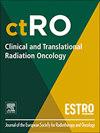三种不同运动管理策略下肺SBRT的剂量学和治疗效果比较
IF 2.7
3区 医学
Q3 ONCOLOGY
引用次数: 0
摘要
目的比较深吸气屏气(DIBH)、自由呼吸(FB)和呼吸门控(RG)策略下肺立体定向全身放射治疗(SBRT)的剂量学和治疗效果。方法与材料回顾性研究308例肺中下区肿瘤患者的肺SBRT。处方为1000 cGy × 5、1200 cGy × 4、1800 cGy × 3。他们都接受了体积调制电弧治疗(VMAT)技术和c臂线性加速器上的6 MV无平坦滤波器(FFF)光束治疗,但采用了不同的运动管理策略(151 DIBH, 136 FB, 21 RG)。回顾性收集这些患者的肺剂量(平均肺剂量(MLD)、V5、V20)和治疗时间(表上、影像学验证、分娩)进行统计学比较。结果对同侧肺的平均剂量(MLD, V5, V20): DIBH组为408.2 cGy, 20.1%, 5.7%; FB组为569.8 cGy, 27.6%, 8.4%; RG组为519.6 cGy, 23.5%, 7.5%。相应的,三个患者队列的平均时间(上台/成像和验证/分娩)分别为22.3/16.0/6.3分钟、13.6/10.5/3.1分钟和22.7/14.6/8.1分钟。结论定量比较了三种常用运动管理策略在肺SBRT中的肺剂量和治疗效果。虽然这些策略的相对优势和劣势是公认的,但我们的研究结果进一步证实了这些差异,并为临床医生提供了定量数据,以支持临床实践中的明智决策。本文章由计算机程序翻译,如有差异,请以英文原文为准。
Dosimetric and treatment efficiency comparison of lung SBRT using three different motion management strategies
Purpose
To compare the dosimetry and treatment efficiency of lung stereotactic body radiation therapy (SBRT) using the deep inspiration breath hold (DIBH), free breathing (FB), and respiratory gating (RG) strategies.
Methods and Materials
308 lung SBRT patients with middle to lower zone lung tumors were included in this retrospective study. The prescriptions were 1000 cGy x 5 fractions, 1200 cGy x 4 fractions, or 1800 cGy x 3 fractions. They were all treated with a volumetric modulated arc therapy (VMAT) technique and 6 MV flattening filter free (FFF) beam on C-arm linear accelerators, but using different motion management strategies (151 DIBH, 136 FB, 21 RG). The lung dose (mean lung dose (MLD), V5, V20) and treatment time (on table, imaging & verification, delivery) of these patients were retrospectively collected for statistical comparison.
Results
The average doses (MLD, V5, V20) to the ipsilateral lung were 408.2 cGy, 20.1 %, 5.7 % for the DIBH cohort, 569.8 cGy, 27.6 %, 8.4 % for the FB cohort, and 519.6 cGy, 23.5 %, 7.5 % for the RG patients. Correspondingly, the average time (on table/imaging & verification/delivery) for the three patient cohorts was 22.3/16.0/6.3 min, 13.6/10.5/3.1 min, and 22.7/14.6/8.1 min, respectively.
Conclusion
Quantitative comparison of lung dose and treatment efficiency for three commonly used motion management strategies in lung SBRT is reported. While the relative advantages and disadvantages of these strategies are well recognized, our findings further confirm these differences and provide clinicians with quantitative data to support informed decision-making in clinical practice.
求助全文
通过发布文献求助,成功后即可免费获取论文全文。
去求助
来源期刊

Clinical and Translational Radiation Oncology
Medicine-Radiology, Nuclear Medicine and Imaging
CiteScore
5.30
自引率
3.20%
发文量
114
审稿时长
40 days
 求助内容:
求助内容: 应助结果提醒方式:
应助结果提醒方式:


